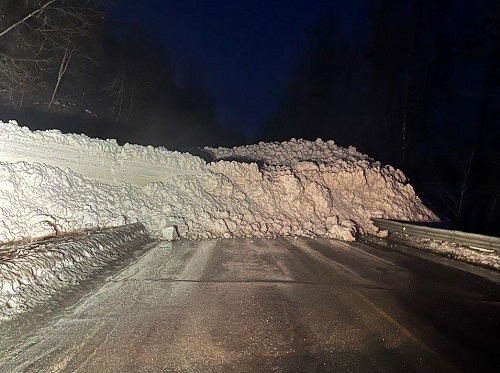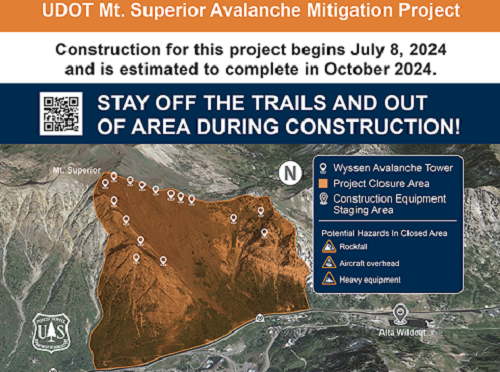The Utah Department of Transportation recently began installing new remote-controlled avalanche mitigation equipment that will enhance safety and improve the efficiency of avalanche mitigation efforts in Little Cottonwood Canyon.
[Above image by Utah DOT]
This summer through October, the agency said it plans to install 16 Wyssen Avalanche Towers in Little Cottonwood Canyon (SR-210) on the Mount Superior ridgeline above the road, State Route 210. While there will be no major road impacts anticipated, canyon visitors can expect occasional, short-term closures in both directions on SR-210 near the town of Alta during the four-month installation effort. Additionally, the bypass road will always remain open as an alternative route to the upper canyon areas, the Utah DOT said.
Using wireless communications, Wyssen Avalanche Towers deploy explosive charges that hang just over ground to trigger an avalanche. Previously, avalanche and road crews used howitzers to trigger approximately 330 controlled avalanches each season.

But with the Wyssen Avalanche Towers, crews will be able to trigger avalanches from a safe location and greater efficiency, explained Utah DOT Avalanche Safety Program Manager Steven Clark.
“This project is part of Utah DOT’s long-term plan to reduce the amount of military artillery fired in the canyon,” he said in a statement. “By using this technology, we will enhance safety and become even more effective at preventing avalanches from reaching our roads.”
Crews will work up to seven days a week, removing loose rock and unstable soil, adding safety features and then beginning the lengthy installation process – a process that includes using special helicopters to lift heavy pieces of equipment to their respective locations, the agency noted.
Utah DOT said it expects the towers to be operational for the 2024 and 2025 winter season. For public and construction crew safety, Mount Superior recreation area closures – including the trails and climbing routes within that area – will be in effect for the duration of the project due to daily helicopter operations and other hazards like potential rock fall, the agency added.
Other state departments of transportation are in the midst of similar avalanche mitigation technology projects as well. For example, several state agencies in Alaska recently collaborated on a major test of drone-based avalanche mitigation technology in February; a system that uses Unmanned Aerial System or UAS craft to place and then remotely trigger explosives to create controlled avalanches in order to protect transportation infrastructure.

The Alaska Department of Transportation & Public Facilities and the Alaska Railroad Corporation used Drone Avalanche Reduction Technology or DART developed by Drone Amplified in January to place and then detonate explosives; safely setting off avalanches from a distance in order to protect vulnerable transportation infrastructure from damage.
The agency – which initially began testing such drone-based systems in May 2023 – said the goal of the program is to shift away from the use of artillery-based avalanche mitigation techniques to ones that rely on UAS.
Meanwhile, in December 2023, the Colorado Department of Transportation installed and safely tested new avalanche mitigation equipment above U.S. Highway 550 on Red Mountain Pass, between Silverton and Ouray.
Two “Gazex” units were permanently installed at slide paths on Red Mountain Pass between Silverton and Ouray, along with three “O’bellx” units at another location on Red Mountain Pass. The O’bellx base features are fixed and permanent, while the portable units holding the gasses require resetting on site each winter.
The systems – remotely controlled with mobile devices like a cell phone or tablet – operate by using compressed air and gasses to create a concussive blast to trigger slides at the top of high-risk avalanche zones. The force of the explosion is directed down toward the snow, producing a purposely triggered avalanche under controlled conditions — a closed highway with no traffic, stressed the agency.
 States
States
NCDOT Staff Participate in ‘Explosive’ Technical Training
December 19, 2025 States
States

